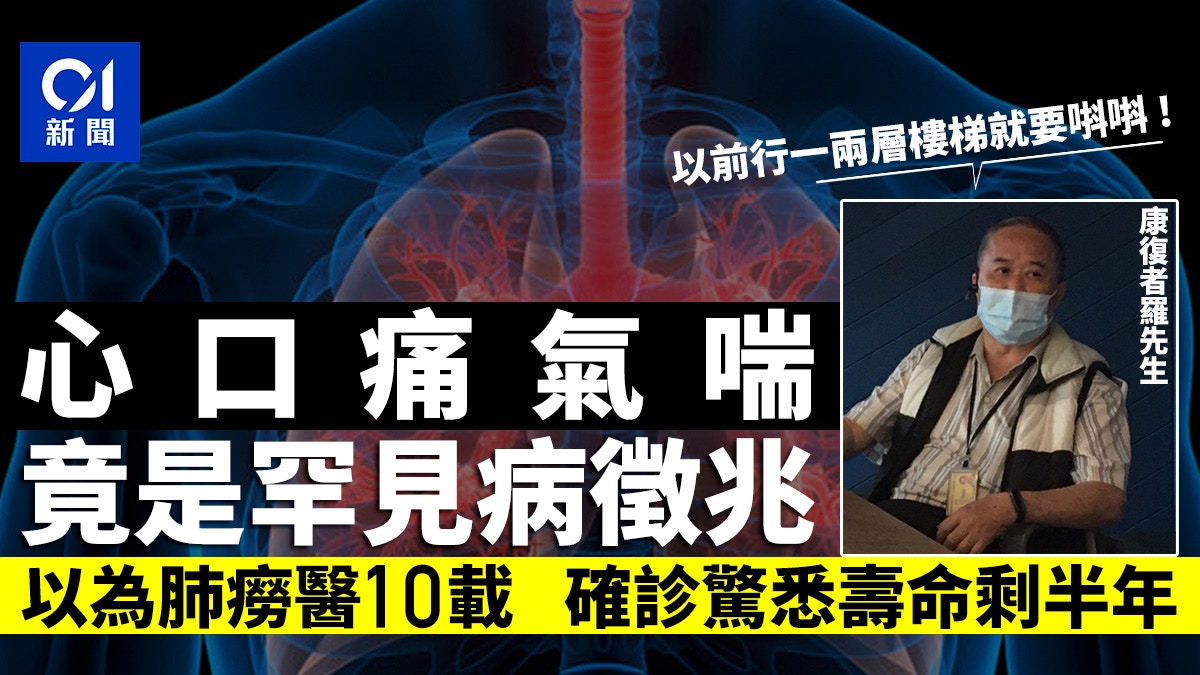"Older age, broken machines" are common aging problems such as shortness of breath when walking, difficulty breathing, chest pain and discomfort.
Or a little careless, it was mistaken as a treatment for tuberculosis, but there may be a rare disease hidden behind it-chronic thromboembolic pulmonary hypertension (CTEPH). If it is not detected and appropriate treatment is given immediately, the five-year survival rate is as low as 10%.
"Most people don’t even know what’s happening, but they’re only aware of heartache." After fainting on the street ten years ago, Mr. Luo continued to suffer from heartache and breathlessness. He was mistakenly treated for tuberculosis. He was diagnosed as rare two years ago. The disease was "embolic pulmonary hypertension". At that time, his life was only about half a year, and his life was saved by surgical treatment.
The 71-year-old Mr. Luo suddenly fainted while crossing the street 10 years ago. It was only after ten years of misdiagnosis that he was diagnosed with rare embolic pulmonary hypertension.
(Photo by Liang Sixing)
In the early stage, if you have severe breathing difficulties, you will die from heart failure.
Mr. Luo, who is over seventy years old, suddenly fainted while crossing the street 10 years ago. After waking up, he continued to have heartaches and was unable to fall asleep for a long time. He also suffered from asthma symptoms while traveling. Stairs to the floor.
When walking on the street on weekdays, every time I walk to a shop, I have to rest for a few minutes and "return my breath."
He initially went to a hospital for treatment, when the doctor diagnosed him as tuberculosis and prescribed antibiotics.
After taking it for about half a month, there is still no improvement, and there are more signs of deterioration.
"If you want to be honest, you have to hit the (experienced) doctor, first see what you have. I don't even know that it's something, but I know it hurts."
Embolic pulmonary hypertension is a rare disease of pulmonary hypertension.
Thrombus and fibrous stenosis form in the arterial lumen of the lungs, which leads to blockage of the pulmonary arteries. Gradually, the pressure on the pulmonary blood vessels increases, causing the patient to have difficulty breathing in the early stages of the disease, and severely lead to heart failure and death.
Cardiologist Dr. Huang Jialin (right) said that the symptoms of chronic thromboembolic pulmonary hypertension are no different from those of general elderly people with poor functioning.
(Photo by Liang Sixing)
Two years after the operation was successful, "you can walk a few streets"
As the condition has been repeated for 10 years and the symptoms have not improved, Mr. Luo was referred to Queen Mary Hospital and finally found a diagnosis of "Embolic Pulmonary Hypertension". If he had not undergone surgery at that time, his life expectancy might be only about half a year.
After a risk assessment, he decided to undergo pulmonary endarterectomy (PEA), and his body has gradually recovered.
At present, two years after the operation, Mr. Luo regularly takes medicine to stabilize his condition, and his breathing is not a serious problem. "Before going up one or two flights of stairs, I would have to scream. Ikea wanted me to walk several streets!"
Hong Kong Rare Disease Alliance President Zeng Jianping (left), 71-year-old Mr. Luo suffering from "embolic pulmonary hypertension", and cardiologist Dr. Huang Jialin (right) explained the rare disease "chronic thromboembolic pulmonary hypertension".
(Photo by Liang Sixing)
Surgery requires thoracotomy, high risk, new drugs to improve survival
Cardiologist Dr. Huang Jialin said that the age of this rare disease is generally about 63 years old. The cause of blood clots can be caused by many different factors. Current research shows that acute pulmonary embolism is the main cause of embolic pulmonary hypertension.
The treatment method mainly relies on PEA surgery, which is not suitable for every patient's body.
"Because PEA surgery requires an open chest, if the patient's body cannot bear the risk, or if it is in the middle or distal position of the lung, the doctor cannot remove the obstructed position."
However, Huang Jialin continued that in recent years, the medical profession has developed sGC stimulants (full name: soluble guanylate cyclase) that can dilate blood vessels. After these drugs enter the vascular smooth muscle, they can dilate blood vessels and reduce pressure.
He pointed out that according to the experience of European and American medical use, patients can continue to improve their exercise capacity for two years after taking it, and the survival rate of continuous taking within six years has reached 80%.
Zeng Jianping, chairman of the Hong Kong Rare Diseases Alliance, pointed out that people with rare diseases in Hong Kong usually need to be diagnosed by multiple different specialties before they can be informed of having a rare disease.
There are so few resources allocated to research and development of rare diseases in Hong Kong. As a result, there is a lack of experienced medical personnel for rare diseases. Some patients have nowhere to seek help because of delays in treatment.
He said that Hong Kong does not have an official statistics on patients with pulmonary embolism pulmonary hypertension, but according to foreign research and local doctors' clinical experience, there are about 3 to 5 people suffering from embolism pulmonary hypertension per million people.
He hopes to increase the understanding of rare diseases among medical staff and researchers and assist in the development of new drugs or therapies.
It is also recommended to establish a roster of patients with rare diseases, establish clinical and medical definitions, and incorporate more drugs into the safety net mechanism.
From nearly 700,000 price reductions to more than 30,000 rare diseases, life-saving drugs "soul bargaining" negotiation process exposed rare diseases, myelofibrosis, early symptoms seem to be aging and easy to be ignored. Fun day full of positive energy

